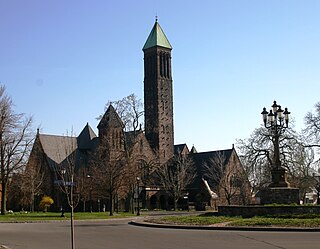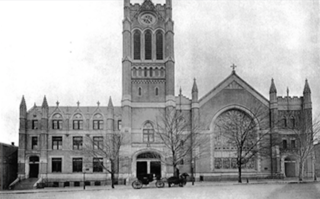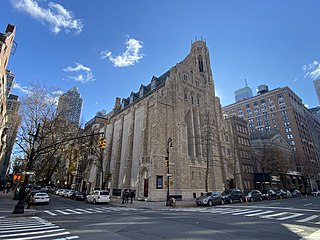
Knox Presbyterian Church is a Presbyterian church in downtown Toronto, Ontario, Canada.

The New York Avenue Presbyterian Church in Washington, D.C., is a congregation of the Presbyterian Church (USA). The church was formed in 1859-60 but traces its roots to 1803 as the F Street Associate Reformed Presbyterian Church and another congregation founded in 1820 on its current site, the Second Presbyterian Church. It is located at the intersection of 13th Street and New York Avenue in the city's northwest quadrant, four blocks from the White House. Due to its proximity to the White House, a number of US presidents have attended services there.

The Reverend Stephen Bloomer Balch was a Presbyterian minister and educator in Georgetown, which is now part of Washington, D.C.. In 1780, Balch established Georgetown Presbyterian Church, which was the second church in Georgetown. He also served as headmaster of the Columbian Academy in Georgetown.

The National Presbyterian Church is a Christian congregation of approximately 1,500 members of all ages from the greater metropolitan Washington, D.C., area. The mission statement of the church is "Leading People to Become Faithful Followers of Jesus Christ Together in God’s World"

Fifth Avenue Presbyterian Church is a Presbyterian Church (U.S.A.) church in New York City. The church, on Fifth Avenue at 7 West 55th Street in Midtown Manhattan, has approximately 2,200 members and is one of the larger PCUSA congregations. The church, founded in 1808 as the Cedar Street Presbyterian Church, has been at this site since 1875.

The First Presbyterian Church in Buffalo, New York was the first organized religious body formed in what was then the western frontier of New York State. The town of Buffalo was sparsely populated when the church was organized on February 2, 1812. However, having survived the War of 1812, the town of Buffalo was rebuilt and rapidly grew with the completion of the Erie Canal in 1825. The first two buildings were located on the same downtown lot. However, the congregation relocated between 1889 and 1891 to its present location approximately one and-a-half miles to the north in a more residential area.
West Presbyterian Church was a congregation and two houses of worship in Manhattan, New York City. The congregation was founded in 1829 and merged in 1911 with Park Presbyterian Church to form West-Park Presbyterian Church. The first house of worship, also known as the Carmine Street Presbyterian Church, in Greenwich Village, was used from 1832 to 1865, and the second, on West 42nd Street between Fifth Avenue and Sixth Avenue, from 1865 until 1911, when it was sold and demolished. Proceeds from the sale were used, in accordance with the merger agreement, to build and endow a church for an underserved neighborhood, Washington Heights: Fort Washington Presbyterian Church. In addition, the West Church congregation had earlier established two mission churches which eventually merged to become Good Shepherd-Faith Presbyterian Church. West-Park, Fort Washington, and Good Shepherd-Faith are all active today.

The congregation of North Presbyterian Church, at 525 West 155th Street in Manhattan, New York City, is a combination of three former congregations: North Presbyterian Church, Washington Heights Presbyterian Church, and St. Nicholas Avenue Presbyterian Church.

Peachtree Presbyterian Church is a megachurch located in Atlanta, Georgia. Peachtree averages about 3200 in weekly worship at two venues on both sides of Roswell Road in the Buckhead region of Atlanta, and is one of the largest Presbyterian congregations in the United States of America.

The Wharf Street Congregational Church was a Congregational church built in 1860 on the corner of Wharf Street and Adelaide Street, Brisbane, Queensland, Australia. The church was demolished in 1928. It was the first Congregational church in Brisbane.

The Peter Muhlenberg Memorial is a public monument in Washington, D.C. It honors John Peter Gabriel Muhlenberg, a Lutheran minister, Continental Army general, Federalist Era American politician, and member of the prominent Muhlenberg family. The memorial is located in a one-acre park bounded by Connecticut Avenue, Ellicott Street, and 36th Street NW on the eastern edge of Washington's Wakefield neighborhood. Designed by architect John Harbeson, it features at its center a bronze bust of Muhlenberg, sculpted by his descendant, Caroline M. Hufford. Completed in 1980, 52 years after its construction was authorized by Congress, attendees at the dedication ceremony included West German ambassador Peter Hermes.

First United Presbyterian Church is a historic church at 309 Lyon Street in Sault Ste. Marie, Michigan.

Bay Ridge United Church (BRUC) was located on Bay Ridge Parkway (636) in the Bay Ridge Section of Brooklyn, New York. The congregation was a blend of two churches from two similar but different denominations and was a member of both the Reformed Church in America and the Presbyterian Church (U.S.A.).

First Presbyterian Church is a historic Presbyterian congregation in Hattiesburg, Mississippi, founded in 1882 by Rev. A. B. Coit. It was the first church in the town and predated Hattiesburg's own incorporation by two years. In 1973 it left the Presbyterian Church in the United States to become a charter member of the more theologically conservative Presbyterian Church in America.

The Presbyterian Burying Ground, also known as the Old Presbyterian Burying Ground, was a historic cemetery which existed between 1802 and 1909 in the Georgetown neighborhood of Washington, D.C., in the United States. It was one of the most prominent cemeteries in the city until the 1860s. Burials there tapered significantly after Oak Hill Cemetery was founded nearby in 1848. The Presbyterian Burying Ground closed to new burials in 1887, and about 500 to 700 bodies were disinterred after 1891 when an attempt was made to demolish the cemetery and use the land for housing. The remaining graves fell into extensive disrepair. After a decade of effort, the District of Columbia purchased the cemetery in 1909 and built Volta Park there, leaving nearly 2,000 bodies buried at the site. Occasional human remains and tombstones have been discovered at the park since its construction. A number of figures important in the early history of Georgetown and Washington, D.C., military figures, politicians, merchants, and others were buried at Presbyterian Burying Ground.

City Presbyterian Church is the name of a church located in Oklahoma City, Oklahoma, United States. The current congregation has no direct connection to the one which originally occupied the building. The building sits on a lot bound by 13th Street and Classen Drive, and therefore has two different street addresses. The "front" of the church is at 1433 Classen Drive, but the address listed on church literature and used for mail delivery is 829 NW 13th Street. The congregation, which informally calls itself "City Pres," is affiliated with the Presbyterian Church in America and is pastored by Rev. Doug Serven.

Saint Stephen Martyr Catholic Church is a Catholic parish church located at 2436 Pennsylvania Avenue NW in Washington, D.C., in the United States. The parish was founded on August 4, 1867, and the first church building consecrated and used for worship on December 27, 1868. This brick structure closed on July 15, 1959, and the current new building was consecrated and first used for worship on June 11, 1961. The church was a favorite of President John F. Kennedy.

Central Presbyterian Church is a historic congregation on the Upper East Side of Manhattan in New York City, founded by pastor and abolitionist William Patton in 1821. It is a member of the Evangelical Presbyterian Church, and it worships in a Gothic Revival structure completed in 1922 that was originally commissioned and largely funded by John D. Rockefeller, Jr. as Park Avenue Baptist Church.

National Baptist Memorial Church is a Baptist church in Washington, D.C. It is located at the intersection of 16th Street NW and Columbia Road, where the Mt. Pleasant, Columbia Heights and Adams Morgan neighborhoods meet. The crossroads is notable for the triple steeples of National Baptist Memorial Church, All Souls Unitarian Church and the Unification Church's cathedral.

Westminster Presbyterian Church is in the Jefferson Park neighborhood of Los Angeles, California. Westminster Presbyterian Church is a member of the Presbyterian Church (U.S.A.), the Synod of Southern California and Hawaii and Pacific Presbytery. The congregation, established in 1904, is one of the oldest African American Presbyterian churches in California and west of the Mississippi River.




















